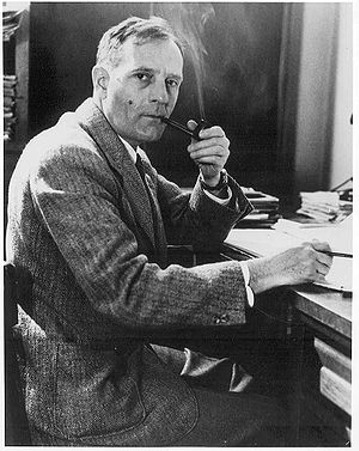It might seem impossible to know anything about the origin of the universe, but Einstein's 1915 General Theory of Relativity, combined with a lot of astronomical observations have turned what was once speculation into quantitative science: cosmology.

Einstein's theory was first confirmed by Arthur Stanley Eddington's eclipse expedition of 1919. Today many astronomical effects are understood to be due to bending starlight, such as Einstein rings and crosses. See here for more on light bending.
Some of the players in the history of cosmology are: Edwin Hubble, Georges LeMaître and Fred Hoyle. Hubble, who is shown at left, discovered the expansion of the universe and has a famous space telescope named after him.
One of the main tools to understand cosmology is the cosmic microwave background radiation. This is the radiation left over from the Big Bang, now stretched out into a very cold microwave background. It has been measure quite carefully by the WMAP satellite among others.
Here is a map made by WMAP of the deviations from uniformity of the background radiation. These bumps can be used to infer things about the evolution of the universe. A famous cartoon of this evolution is here. The surprizing result is that the universe is composed not only of ordinary matter, but also unseen Dark Matter and even weirder Dark Energy. Here is a pie chart of the composition implied by the observations. Dark energy is a kind of negative pressure that inflates the universe; the discovery of this acceleration won the 2011 Nobel Prize in Physics. Here is a nice news story on all this.
The accelerating expansion of the universe can be incorporated into Einstein's general relativity by adding a "cosmological constant". Einstein originally included this term to fudge his theory into predicting a static universe, a ploy he later called "the greatest blunder of my life".
Working forward from the fluctuations in the density of the early universe, it is possible to simulate the evolution of galaxies, which have an interesting lumpy texture. Galaxies form from the mutual gravitational instability of the matter and dark matter. One can even account for the spiral structure of the Mily Way.
Starting from the standard model and the Big Bang, how do we build a universe? The first stop, just after the symmetry breaking events in the very early universe, is when the quarks assemble themselves into baryons (protons and neutrons). The universe is then a hot plasma of ionized hydrogen, which eventually cools and becomes transparent. At this stage the background radiation escapes. Then this neutral cloud collapses into stars and galaxies and other stuff like early black holes and quasars. Along the way, all the elements heavier than Hydrogen are synthesized first by a little cooking just after the big bang, and then later in the interior of stars.
Nuclear fusion joins protons and neutrons into heavier nuclei. Stellar evolution returns the matter back to the interstellar medium, which can reform into new stars for more cooking. If they are cold enough, nuclei collect electrons to become atoms. Even the same element can have different arrangements of protons and neutrons in the nuclei. The elements can be combined into a famous song. Which is sometimes sung by famous people. Then atoms of the various elements to may be linked by chemical bonds to form molecules, and eventually important biomolecules.
Atoms are something we can "see" directly, for example using a scanning probe microscope. Once can even move individual atoms around using such a microscope. Normally, objects the size and weight of atoms and molecules behave as classical physics would predict, so the chemical bond is approximately the limiting size at which quantum effects are important in everyday Nature. Of course, there are famous exceptions like superconductors (see video) or superfluids (see video).
Tablet notes: [Lec 11] [no notes for Lec 12 ]